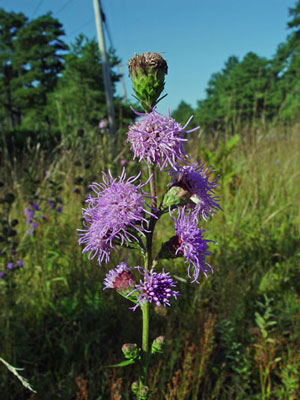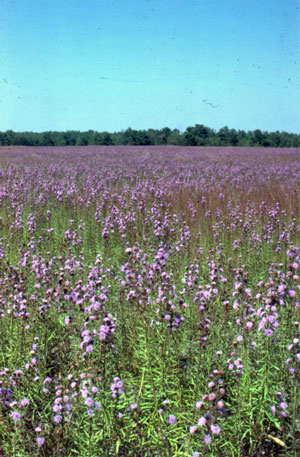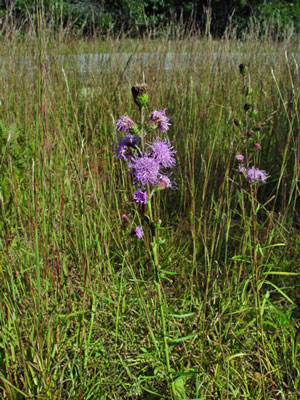DACF Home → Bureaus & Programs → Maine Natural Areas Program → Communities, Plants, and Animals → Rare Plants → Liatris novae-angliae

Liatris novae-angliae (Lunnell) Shinners
Northern Blazing Star
- State Rank: S1
- Global Rank: G5T3?
- State Status: Threatened
Habitat: Dry grasslands, barrens, and woods openings. [Dry barrens (partly forested, upland)]
Range: Southern Maine to eastern New York, south to New Jersey and eastern Pennsylvania.
Aids to Identification: A showy purple-flowered perennial growing from a bulb with a basal rosette of lanceolate leaves 0.5-3 cm broad. The numerous, stalked, thistle-like flowers form a loose spike above the linear stem leaves.

Ecological characteristics: L. scariosa is most often associated with sand barrens. Most of its stations in Maine are on sandy soil, and the largest Maine population is thriving on a grassland barren which is periodically burned.
Phenology: Flowers July - September.
Family: Asteraceae
Synonyms: Represented in Maine and New England by variety novae-angliae. Synonyms include Lacinaria scariosa (L.) Hill var. novae-angliae Lunell; Liatris borealis, auct. non Nutt. ex J. McNab; Liatris scariosa (L.) Willd. var. novae-angliae (Lunell) Gandhi, S.M. Young, & P. Somers.
Known Distribution in Maine: This rare plant has been documented from a total of 7 town(s) in the following county(ies): York.

Reason(s) for rarity: At northern limit of range, habitat limited. Research indicates that high levels of seed predation by a small moth may be a factor in declining populations rangewide.
Conservation considerations: Controlled fire or prescribed burns may be an important management tool for northern blazing star. Fires control seed predator abundances and encourage recruitment of juvenile plants into resident populations.
For more information, see the Native Plant Trust's Conservation Plan for Liatris scariosa var. novae-angliae.